In a Nutshell:
- Using a non-toxic and plastic-free coffee maker is important because of the toxic chemicals that can leach from plastic. The plastic’s contact with acidic and hot liquids (coffee) along with daily use can increase your exposure to these chemicals.
- Even “BPA-free” coffee makers can contain other bisphenols (such as BPS and BPF) which can be just as harmful as BPA.
- When choosing a non-toxic coffee maker, glass is usually best, followed by porcelain and stainless steel, and then low-plastic options.
- It’s much easier to find affordable plastic-free coffee makers for manual brewing. For example, pour-overs and French presses are great options.
- There are not currently any plastic-free automatic drip coffee makers on the market. Ratio offers an automatic coffee maker with the lowest amount of plastic, but it comes with a hefty price tag.
- Even if you do use an automatic coffee maker that’s made from plastic, there are things you can do to reduce your exposure to potentially harmful chemicals. For example, you can use a glass carafe and minimize the amount of time that water sits in the plastic resevoir.
You’ll see a lot of “BPA-free” coffee makers on the market, but don’t be fooled. These plastic coffee makers can still contain endocrine disrupting chemicals that are very similar to BPA.
So then, what’s the healthiest coffee maker? Well, 100% plastic-free coffee makers are the best option… But whether or not you’ll actually be able to find one depends on the brewing method.
This article will lay out all of your options, along with some of the pros and cons for each, so that you can decide which non-toxic (or at least less-toxic) coffee brewing method is right for you.
Table of Contents
- Why Go for a Non-Toxic Coffee Maker?
- When BPA-Free Coffee Makers are NOT Non-Toxic
- Okay, So What is the Healthiest Material for a Coffee Maker?
- Other Things to Consider
- Non-Toxic and Plastic-Free (or Low-Plastic) Coffee Makers
- Pour Over
- Chemex
- Hario
- Public Goods
- French Press
- GROSCHE
- Yield
- Automatic Drip Coffee Maker
- Ratio
- Espresso Machine
- Even More Low-Plastic Coffee Brewing Options:
- What About an AeroPress?
- Is a Keurig Non-Toxic?
- What About Instant Coffee?
- Other Accessories and Supplies for a Non-Toxic Coffee Routine
- Filtered Water
- Kettle
- Coffee Bean Grinder
- Filters
- Don’t Forget the actual coffee!
- What Should You Store Your Coffee In?
- Mold Prevention and Cleaning for Your Coffee Maker
This article contains affiliate links, which means we may earn a commission if you decide to make a purchase. As always, all recommendations are honest. Featured Image Credit: Ratio
Why Go for a Non-Toxic Coffee Maker?
The main concern with coffee makers has to do with the plastic involved. The primary chemicals of concern when it comes to the hard plastic (usually polycarbonate) used in coffee makers are bisphenols, such as BPA and BPS. These chemicals are often added to plastic to make them harder and more durable.
BPA is a known endocrine disruptor that’s linked to various health issues, including:
- Heart disease
- Cancer (including breast and prostate)
- Metabolic disorders (such as diabetes)
- Childhood asthma
- Fertility issues (such as reduced sperm count and recurring miscarriages)
- Birth defects
- Developmental, behavioral, and learning issues like ADHD and aggression
- Mental health concerns like anxiety and depression
- Inflammatory bowel disease (including ulcerative colitis and Chrohn’s disease)
As if that’s not concerning enough, research shows that BPA often doesn’t follow the classic “the dose makes the poison” paradigm. Instead, even low levels of BPA that have been deemed as “safe” have the ability to disrupt healthy function and lead to developmental problems, cancer, and more.
BPA and related bisphenols can leach out of containers and into the food or drink that’s stored in them. Then we consume that food or drink, ingesting the chemicals into our bodies.
Decreasing the amount of plastic in your coffee maker is especially important for three main reasons:
- Heat: Higher temperatures increase the amount of BPA and other chemicals that are leached from the material. Unless you’re making an overnight cold brew, you’re likely using heat every time you make coffee.
- Acidity: Like heat, acid can also cause plastics to break down faster, and most people are aware that most coffees are pretty acidic.
- Frequency of use: Ideally, anything you use more frequently should be higher on the priority list when it comes to swapping out for a non-toxic (or at least less toxic) option. Most people are using their coffee maker daily or almost daily, so switching to a plastic-free coffee routine could be a great way to decrease your daily intake of BPA and other plastic chemicals.
When BPA-Free Coffee Makers are NOT Non-Toxic
BPA has become quite notorious in recent decades, so most people are at least somewhat aware of its potentially negative effects on health.
However, getting a “BPA-free” coffee maker may not actually be as “safe” as one thinks.
This is because when BPA started getting a bad rap, manufacturers started replacing BPA with very similar chemicals such as BPS and BPF, allowing them to slap a “BPA-free” sticker on their product without actually solving the problem of endocrine disruption exposure.
(Other bisphenols like BPS and BPF have been shown to be just as bad as BPA. You can read more about that here.)
This is why you’ll ideally want to go for a completely plastic-free coffee maker, as opposed to one that’s just “BPA-free.”
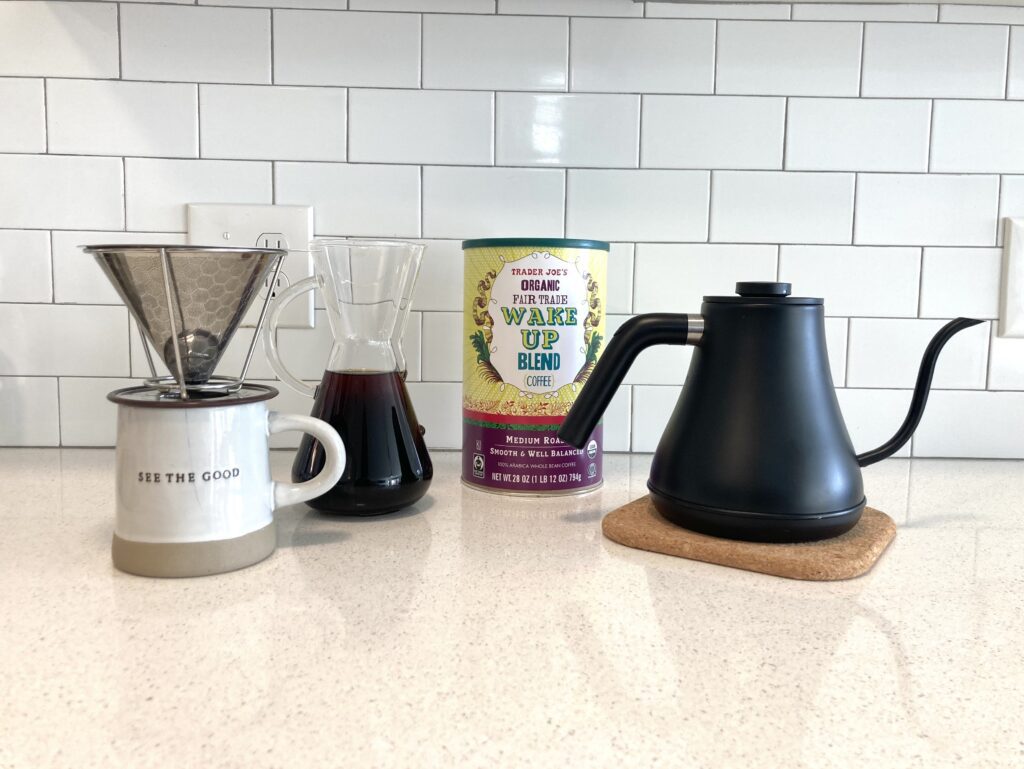
Okay, So What is the Healthiest Material for a Coffee Maker?
When choosing a plastic-free coffee maker, here are the safer materials you’ll likely want to look for instead of plastic:
Glass
Glass is one of the safest materials for coffee, tea, and other drinks. It’s generally inert, meaning that chemicals don’t leach from it. Look for borosilicate glass, which is not only more resistant to thermal shock, but is also even more resistant to chemical leaching and absorbent than other types of glass.
Stainless Steel
You’ll find stainless steel used in non-toxic coffee makers as well. There are stainless steel cones for pour overs, stainless steel carafes, percolators, and more. Of course, espresso machines use quite a bit of stainless steel as well.
Some people may be concerned about whether or not stainless steel will leach heavy metals such as lead or chromium (especially with acidic foods or liquids). Some stainless steel products even come with a California Prop 65 warning label because of the potential negative health effects of lead and chromium.
High-quality 18/8 stainless steel (food-grade and/or medical-grade) is generally inert, meaning metals like lead, chromium, or nickel should not leach from it. Studies have really only found metals to leach from stainless steel cookware when acidic foods (like tomato sauce) are cooked for long periods of time (2 to 20 hours).
This is worth considering when you choose your coffee maker because whether or not this may be an issue for you may depend on your coffee routine. If you make your coffee and drink it within an hour-ish, then you’re likely safe to use high-quality stainless steel.
But if you let your coffee sit in a stainless steel carafe all day, keeping it on the heat and drinking from it every couple of hours, then you may not want to use a stainless steel carafe.
You shouldn’t have to worry about using stainless steel for parts that don’t have contact with the liquid for a long period of time (such as a pour over cone).
It’s also worth noting that leaching tends to be significantly reduced or stop altogether over time and after several uses, meaning that stainless steel coffee makers, tumblers, and cookware that are at least several months old may actually be safer.
When in doubt, look for a Prop 65 warning on your coffee maker and/or reach out to the manufacturer to ask if they’ve been tested for Prop 65 compliance.
Those who have a nickel sensitivity and/or have tested for high levels of nickel in their bodies should also opt out of stainless steel coffee makers.
So, just to clarify: The only reason one may want to consider their use of stainless steel when it comes to coffee makers and/or mugs is because it’s hot and acidic and being held in the container for a very long period of time. Other uses of stainless steel are generally fine.
And one last note on this: all things considered, stainless steel is still a much safer option than plastic. So if you’re choosing between the two, go with the stainless steel.
Porcelain
Porcelain is another material that’s used mainly for pour over cones (as well as coffee mugs, of course!). Porcelain has also been found to contain traces of heavy metals such as lead. In order to avoid lead in porcelain, look for Prop 65 compliance (like this one from Public Goods) and avoid brightly-colored porcelain, as those are more likely to contain heavy metals. (Go with white instead.)
Minimal Plastic
Depending on what kind of coffee maker you want, you may not be able to avoid plastic completely. This is especially true of automatic drip coffee makers, which almost always use plastic for at least some of their parts.
When this is the case, you’ll want to try and choose a coffee maker that uses as little plastic as possible, especially for the parts that actually come into contact with the liquid: the water tank, the shower head, the brew basket, and the pot.
There are some tips below on how to decrease your exposure to toxic plasticizers even if you do use a plastic coffee maker.
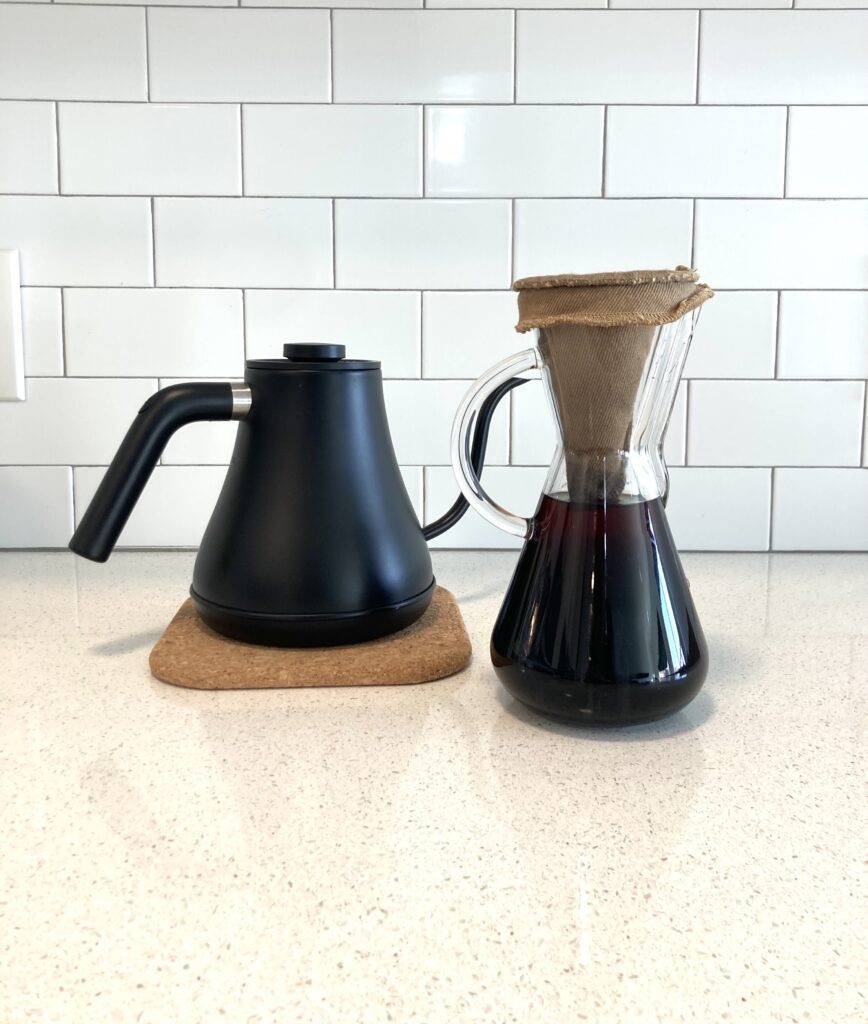
Other Things to Consider
Of course, material safety is just one factor to think about when you’re choosing your coffee maker… You’ll also want to get something that actually fits well with your preferences!
1. Convenience & Routine
Consider your daily routine, including how and where you’ll be drinking your coffee and how much time you have to make it.
As already mentioned, it’s much easier to find manual coffee makers that are non-toxic and truly plastic-free. So if you work from home or have more time in the morning, something like a pour over might be a great fit for you.
However, if you’re often in a rush to get out the door in the morning, an automatic drip coffee maker might be more realistic for you. Since 100% plastic free drip coffee makers don’t exist, try to choose one with the least amount of plastic possible.
Also think about where you’ll be making and drinking your coffee: at home, on the go, at the office? This may also determine what types of brew kit will work for you. You may even choose a different coffee brewing method for the weekdays versus weekends.
2. Taste Preferences
Are you someone who likes their coffee to taste a very specific way, or will you drink anything?
For example, a French press is a great option for a non-toxic coffee maker that’s relatively quick and easy… but some people don’t prefer a French press because the coffee can have a grittier texture. Or, you may prefer to go with shot of espresso each morning instead of regular coffee!
3. Budget
The amount of money you can potentially spend on coffee brewing supplies varies widely. You can grab a pour over cone and a reusable filter for $20 or less, or you can easily spend hundreds of dollars on a low-plastic automatic drip coffee maker, a fancy grinder, an espresso machine, and other brew gear.
4. Space
How much space do you have on your countertop (or wherever you’ll be making your coffee)? Do you need something that will need to be stowed away after each use, or can you get something that can sit on the counter all day long?
5. Number of People Served
How many people will be drinking from your coffee pot, and how much coffee does each person drink? If you need to make a lot of coffee at once, this will obviously eliminate certain options, like a french press or a single-cup pour over.
Non-Toxic and Plastic-Free (or Low-Plastic) Coffee Makers
Alright, now let’s get to your options for non-toxic and plastic-free coffee makers so you can choose what’s best for you:
Pour Over
If you have the time, using a pour over coffee maker is one of the best options: it’s easy to find affordable supplies that are all or mostly glass.
Here are a few good options:
Chemex
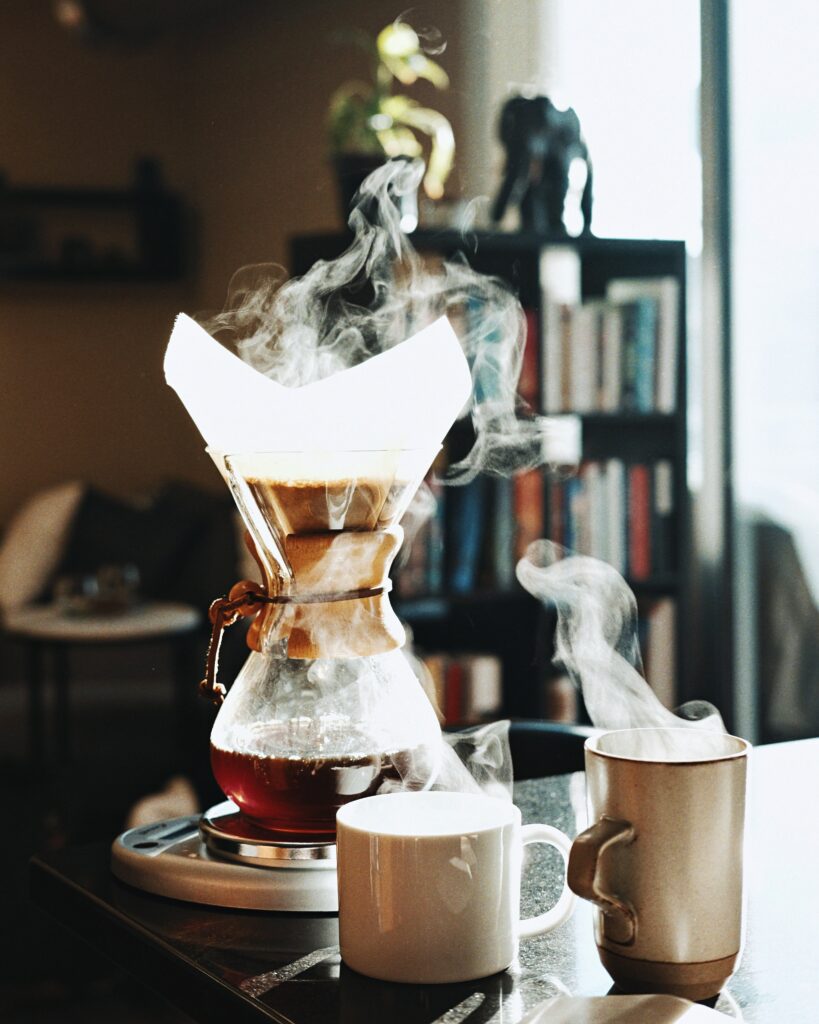
I’ve used Chemex’s pour over coffee makers for years now. The classic designs are almost entirely borosilicate glass, with a little bit of wood and leather on the outside. (They also have some all-glass options as well, which have handles.)
Chemex offers various sizes, from 3-cup to 10-cup. Most of their pour overs require filters (see below for how to choose a non-toxic coffee filter). They also offer a stainless steel reusable pour over cone and other fancy accessories and supplies—including a hand-blown glass water kettle! They also have a machine that will turn your pour over carafe into an automatic drip coffee maker, but unfortunately it uses plastic for the water tank and shower head.
Price range: $40-$150
Shop at Williams-Sonoma, Crate & Barrel, or ChemexCoffeeMaker.com
Hario
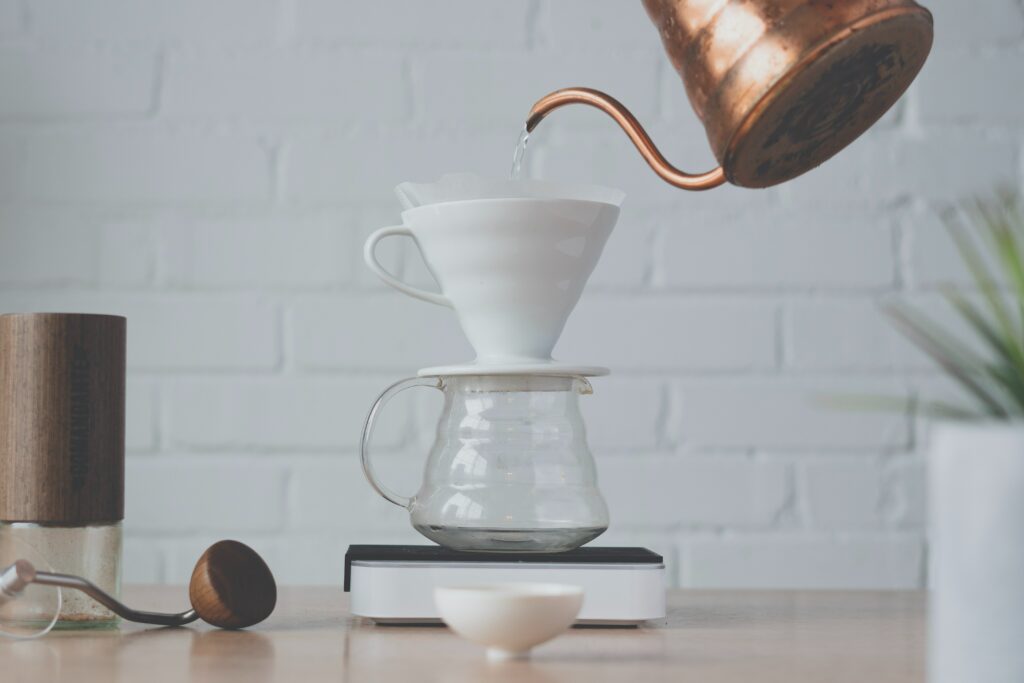
This is another classic brand that’s been serving up coffee brewing supplies since 1921. They offer a wide variety of pour over drippers, including some we do recommend (like the glass, white porcelain, and stainless steel) and others we do not recommend as much (like the plastic or the colored porcelain).
They have various brew kits that include glass carafes, as well as French presses, kettles, filters, grinders, drinkware, and even fancy coffee siphons!
Price range: $20-$175
Shop at Williams Sonoma or Hario-USA.com.
Public Goods
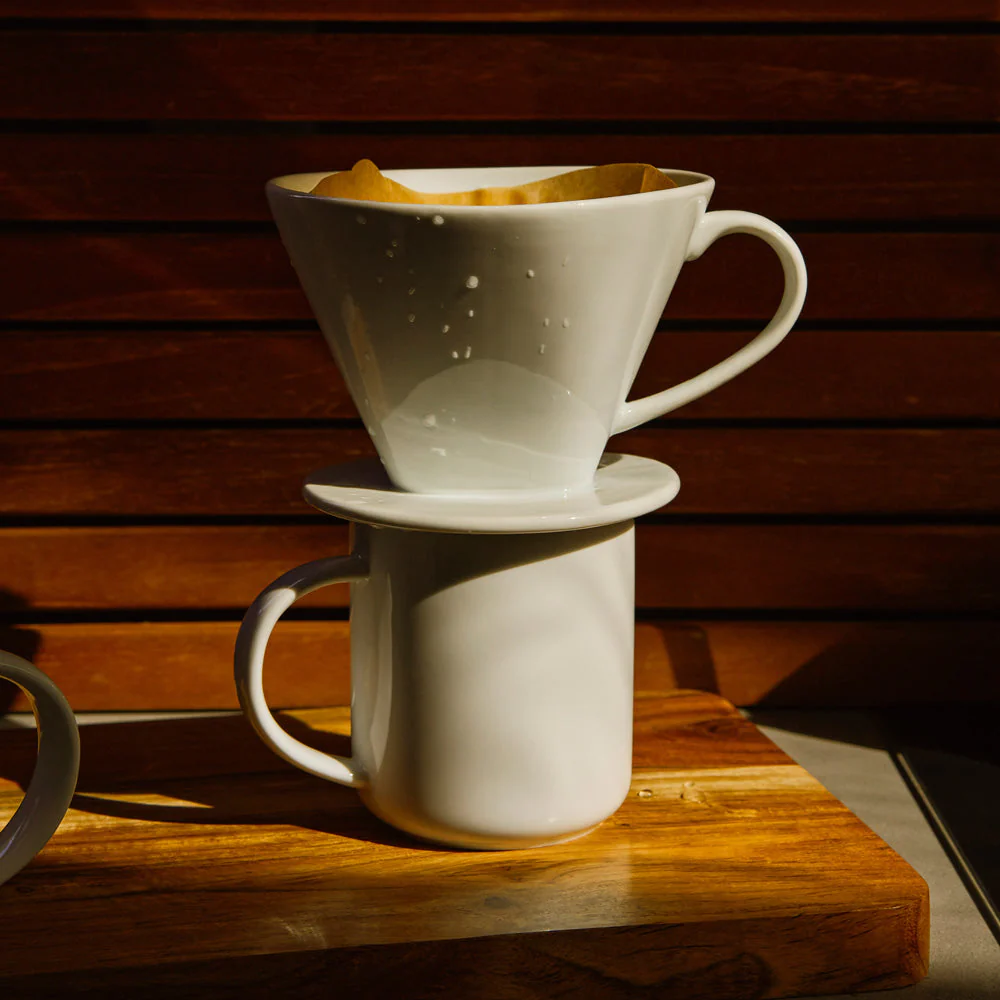
For a simple and affordable option, Public Goods offers a porcelain pour over option that’s Prop 65 compliant. It’s great for two smaller servings or one larger one. (It fits perfectly with their 15-oz mugs.)
They have a French press, too.
Price: $16.95
French Press
French presses are very easy to find. They’re usually pretty affordable and they require less effort compared to a pour over (since you don’t have to stand there and keep pouring more water into the top).
French presses are usually available in glass and/or stainless steel. Again, you may not want to leave your coffee sitting in stainless steel for hours on end, so if you drink your coffee slowly throughout the day, you’ll probably want to go with glass. (Most glass ones do come with a stainless steel filter and/or lid, but I wouldn’t worry too much about this small amount of stainless steel.
Some French presses come with plastic parts, but it’s not difficult to find a completely plastic-free French press.
GROSCHE
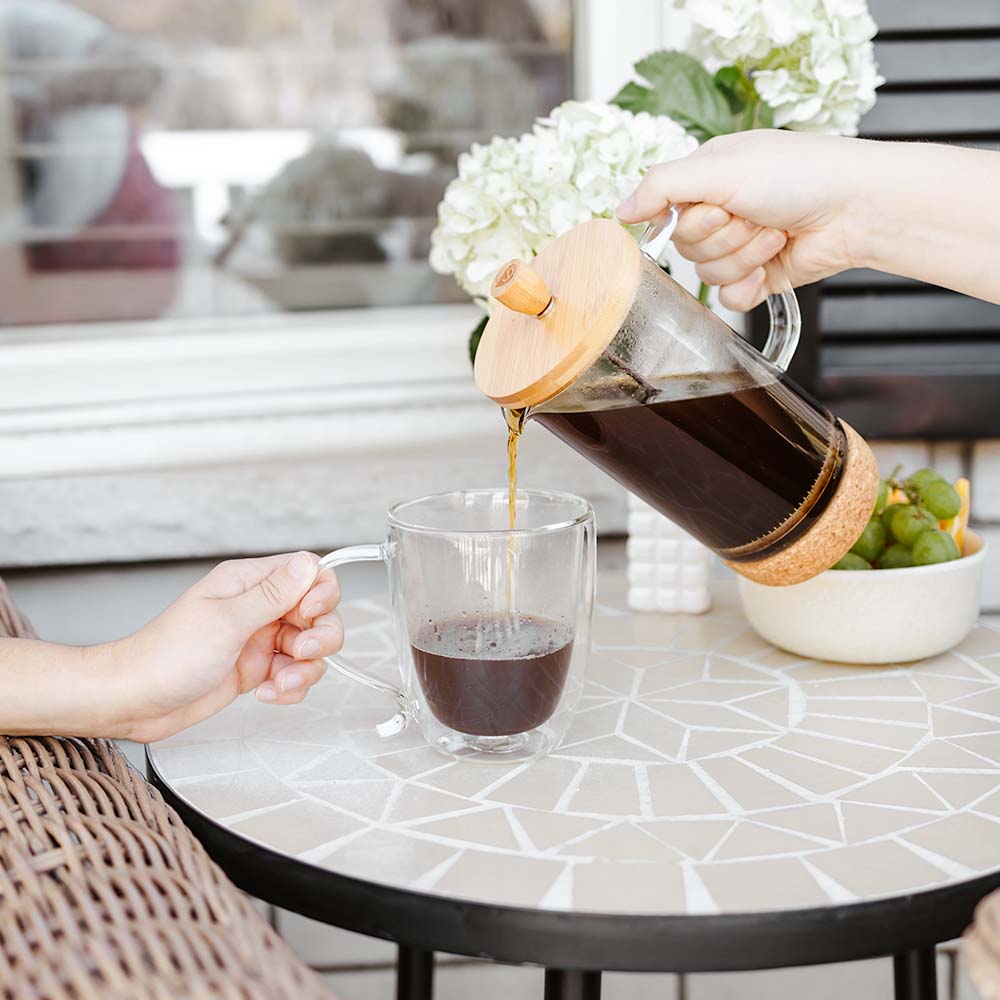
GROSCHE has a lot of options, including an all-stainless steel French press (which you can personalize if you want), and one that’s made out of glass, cork, and bamboo.
They also have stainless steel stovetop espresso makers, glass pour overs, grinders, and other accessories.
Price range: $25-$70
Shop at grosche.ca or at Target
Yield
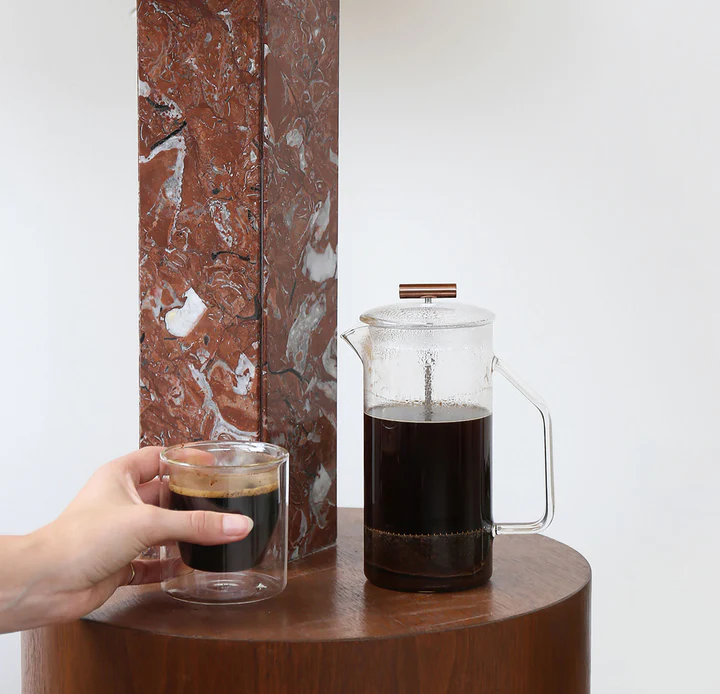
This beautiful French press is made mostly out of glass, with stainless steel for the filter part. They also have all-glass pour over carafes and other glassware, as well as a ceramic French press.
Price range: $85-$120
One of the biggest downsides to pour over and French press brewing is that they don’t come with a built-in warmer like most automatic coffee makers do.
But, there are methods for keeping your coffee warm longer: you can get a lid or use a mug warmer/hot plate. (Just make sure the specific container you’re using can be put on a heated surface and what the max temperature should be.)
Automatic Drip Coffee Maker
This is a tough one. It’s completely understandable that some people want or need to use an automatic coffee machine, but it turns out they don’t actually make one that’s completely plastic-free (at least not that we’ve found!).
So first, let’s look at the coffee maker we found with the least amount of plastic, and then we’ll give you some more pointers on what to do if you can’t avoid plastic altogether.
Ratio
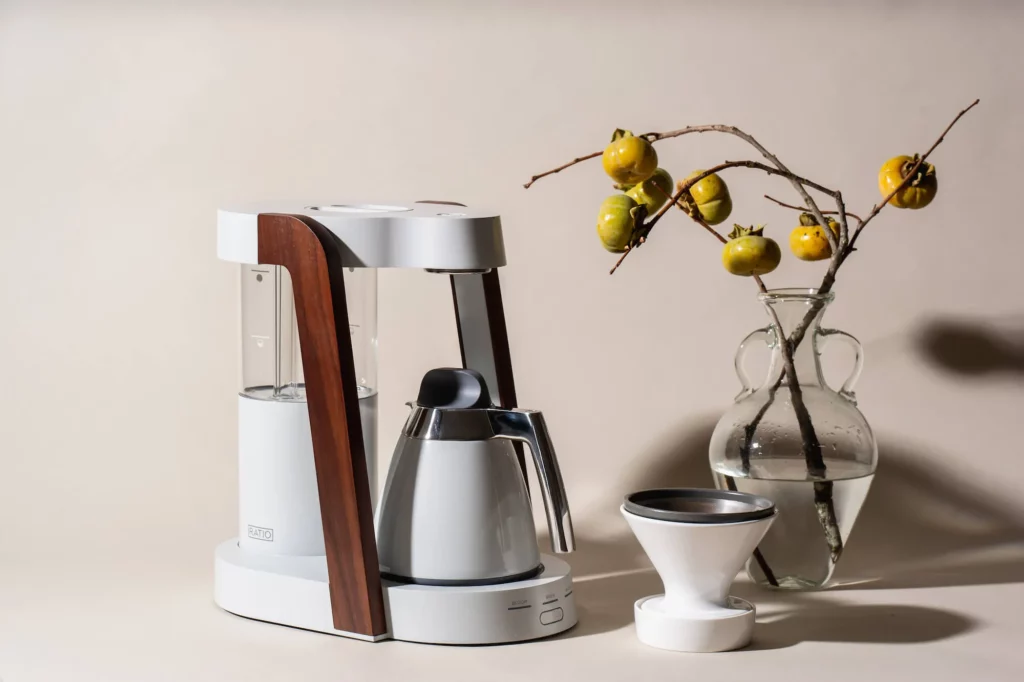
The Ratio Eight coffee maker is a great option for a number of reasons:
- They use as little plastic as possible. The plastic they do use is mostly Tritan (more on that in a minute) and is medical-grade.
- The supply lines are made out of handblown borosilicate glass and the shower head is stainless steel.
- The carafes are made out of handblown glass or stainless steel.
- This is the only brand we’ve found that offers a glass water tank.
- It’s customizable (you can choose the body color, the type of wood for the accent, and you can easily swap out carafes & accessories)
- Even though it brews with the push of a button, it mimics hand-made pour over coffee.
- The Ratio Eight coffee makers are designed and assembled in Portland, Oregon, USA. (The Ratio Six one is made in China.)
- It looks nice!
Ratio offers a few different machines (you can compare them here), with the Ratio Eight Thermal Set being the coffee machine with the absolute least amount of plastic we were able to find. The water tank and supply lines are made from glass and you can use either a glass or stainless steel carafe.
It comes with quite a price tag ($845), but they do offer a 30-day “Love It Guarantee” and a 5-year warranty.
Price range: $295-$845
Other Low-Plastic and BPA-Free Automatic Coffee Makers
What if you want an automatic coffee maker but can’t (or don’t want to) spend that much? Here are a few things to look for:
- At least choose a coffee maker that uses a glass or stainless steel carafe. The carafe is arguably the most important part to make sure is plastic-free because it’s where your coffee sits the longest (leaving more opportunity for leaching). It’s easy to find affordable automatic coffee machines with glass carafes from brands like Mr. Coffee.
- Minimize the amount of plastic-to-liquid contact time. That might mean spending an extra 30 seconds filling the water tank in the morning instead of filling up the night before and letting it sit there overnight. And if you do have a plastic carafe, you could transfer the coffee to a different container right after it brews instead of letting it sit there for an hour (or however long).
- If the coffee maker came with a reusable filter that includes plastic, you could consider swapping it out with one that’s made out of stainless steel, organic cotton fabric, and/or paper filters. (More on how to choose non-toxic filters below.)
- For the plastic parts, look for brands that use “least-bad” plastics like Tritan. Although Tritan is still somewhat controversial (you can read more about that here), it’s purported to be free from not only BPA but also all bisphenols and other hormone disruptors. Here are some more affordable brands that use Tritan (and similar) plastics in their coffee makers:
- Haden (starting at ~$70 and available at a lot of retailers like Target, Walmart, Crate&Barrel, and Williams Sonoma)
- Moccamaster (starting at ~$250; available at retailers like Crate&Barrel and Williams Sonoma, and Walmart)
- Breville (starting at ~$300; also available at retailers like Williams Sonoma, and Crate&Barrel)
- Mr. Coffee (starting at ~$25; available at retailers like Target, Walmart, and Best Buy)
- Ninja (starting at ~$100; also available at retailers such as Target, Walmart, and Best Buy)
Important Note: Although these brands do use Tritan plastic in at least some of their products, they may not use it in all of their products and parts. For example, some of Mr. Coffee’s coffee makers are BPA-free and others are not. Don’t hesitate to reach out to the brand to ask about a specific product.
Espresso Machine
Most espresso machines are low on plastic, using a lot of stainless steel instead. These really range in terms of price and capabilities as well, so if you want an espresso machine, you’ll probably want to do some more research in order to find the different barista features you want. But here are a few (almost) plastic-free espresso machines to check out (that also get great reviews for espresso lovers!):
- Rok: This is a manual espresso machine that uses the least amount of plastic we’ve been able to find yet. (It also doesn’t use electricity and is meant to last a lifetime!)
- Breville
- Diletta
- Jura
- Rancilio
Even More Low-Plastic Coffee Brewing Options:
Here are even more plastic-free coffee makers that are not as widely used:
- A stainless steel moka pot for a stovetop espresso maker.
- Ovalware plastic-free cold brew maker – made of glass, stainless steel, and silicone. (They also have pour over supplies and other accessories)
- Stainless steel or copper Turkish coffee pot. (Note that copper will need to be re-tinned if & when the copper starts to become exposed on the inside. You can read more in our cookware guide.)
- Coffee siphon – made mostly of glass, you can find all kinds of different types (and they look cool!)
- Electric or stovetop percolator – made mostly of stainless steel
What About an AeroPress?
The AeroPress is a manual BPA-free coffee maker that’s loved by campers and travelers. However, it’s made almost entirely of plastic (polypropylene), along with a few silicone parts. Although the plastic is “FDA and EU approved for use in contact with food” and “are free of BPA and phthalates,” that doesn’t necessarily mean it’s free from all bisphenols and any other endocrine disruptors. Therefore, we don’t recommend AeroPress as a good non-toxic coffee maker, especially for everyday use.
Delter, another brand that’s similar to AeroPress, uses Tritan plastic for their manual coffee maker. As discussed above, Tritan is one of the “least-bad” types of plastic, but it still definitely cannot be considered a plastic-free coffee maker. You’d be better off using a French press if possible.
Is a Keurig Non-Toxic?
Are Keurigs non-toxic? This probably won’t be too surprising to you, but we don’t recommend Keurig as a non-toxic coffee maker, especially on a regular basis.
Not only does the Keurig machine itself use a lot of plastic, but most of the pods are made from plastic as well. Not only is this wasteful, but it can also expose coffee drinkers to plasticizers that may leach from the pods into the coffee as it’s being made. Although many Keurig pods are BPA-free these days, there’s no indication that they’re also free from other toxic bisphenols, phthalates, or other harmful plastic chemicals. You can learn more about this here.
Keurigs are also notorious for growing mold, which can then get into your coffee and make you sick.
If you are going to use a Keurig, make sure you clean it often and go with a low- or no-plastic coffee pod option. You can get a reusable stainless steel pod that you put your own ground coffee into, or you can go with a paper pod option.
What About Instant Coffee?
If you like the taste and texture of instant coffee, then it’s certainly a great option that only requires some hot water, a mug, and a stirring utensil.
The main downside to instant coffee is that it tends to have higher concentrations of acrylamide compared to regular coffee. Acrylamide is a probable carcinogen and a neurotoxin. (It’s found in other foods too, as well as smoke.)
Although most research so far has only found negative effects at high levels of acrylamide (levels higher than what we’d get through diet), it may be worth being mindful when you consider how much instant coffee you consume. For example, you may want to just stick with instant coffee when you’re traveling and drink regular coffee when you’re at home.
Go organic when you can to decrease exposure to pesticides. Here are some places to get organic instant coffee:
- Four Sigmatic
- Blue Bottle Coffee
- Thrive Market
- Om Mushrooms
- Mount Hagan
- Black Coffee Roasting Co.
- You could also try something like Golden Ratio, which is a lighter coffee option that brews like tea.
Other Accessories and Supplies for a Non-Toxic Coffee Routine
Filtered Water
Filtering your water is not only important for your health but also for the quality of your coffee and for preserving the long-term durability and function of your coffee maker.
Not only can the minerals and/or chemicals in tap water affect the taste of your coffee, but it can also lead to mineral buildup in your machine and/or reusable coffee filters. Coffee shops and roasteries always have their water filtration dialed in so they can give their customers excellent tasting coffee while protecting their machinery.
Everyone’s water and living situation is different, so it’s hard to recommend a one-size-fits-all water filter. However, one of the most universal filters you can check out is AquaTru. It uses a reverse osmosis filtering method (which filters out most toxicants) and since it sits on the countertop, it can be easily used by both home owners and renters. (It’s also the one I’ve been using for years.) This link will save you $100 on an AquaTru if you decide to buy one.
(If you want to be extra fancy, you can also use Third Wave Water to add back the minerals you took out when filtering.)
Kettle
Depending on which brew method you choose, you may need a kettle as well. We’re working on a separate guide all about non-toxic tea kettles, so stay tuned for that soon!
Coffee Bean Grinder
I personally prefer to buy whole bean coffee and grind it right before I brew it for a much fresher cup.
You shouldn’t have to worry about grinders too much because even most plastic grinders use stainless steel for the parts that actually grind the beans. Plus, you’re probably not going to keep your coffee sitting in the the grinder for very long.
Manual grinders usually have the least amount of plastic, but they can be inconvenient for everyday at-home use. (Although they’re great for traveling and camping.)
Otherwise, you can just use a simple electric grinder like this one from Bodum.
Filters
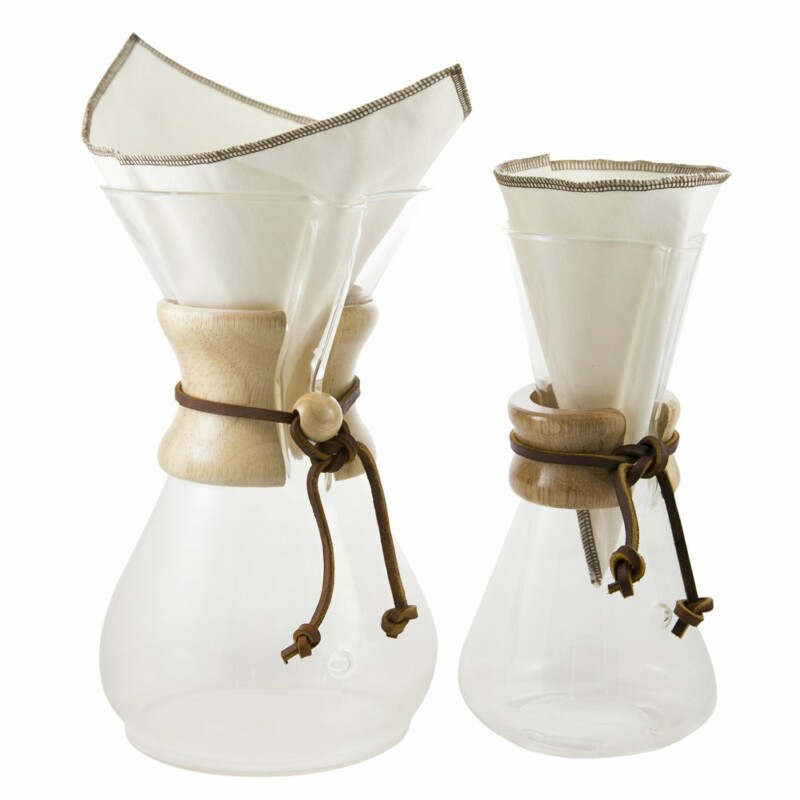
Your two main options when it comes to filters for your coffee maker are paper or fabric.
If you want to use single use paper filters, look for unbleached / TCF (total chlorine free) ones. This will help prevent you from being exposed to toxic dioxins and furans that result from the chlorine bleaching process. If You Care is a recognizable brand that’s relatively easy to find in stores. You can also find some at Public Goods.
Coffee Sock, for example, offers reusable fabric filters that are made out of GOTS certified organic cotton and are available in a variety of different shapes and sizes (cone, traditional basket, tea bag, etc.).
Ebb Filter is a similar option—these reusable fabric filters use organic cotton that’s grown in Texas, woven in South Carolina, and sewn together in Oakland, California.
If you do use a reusable fabric filter, you’ll want to rinse the grounds out shortly after you brew your coffee in order to give the filter time to air dry before it has the chance to start growing any mold. You’ll also want to boil the filter every month or so to clean it.
Don’t Forget the actual coffee!
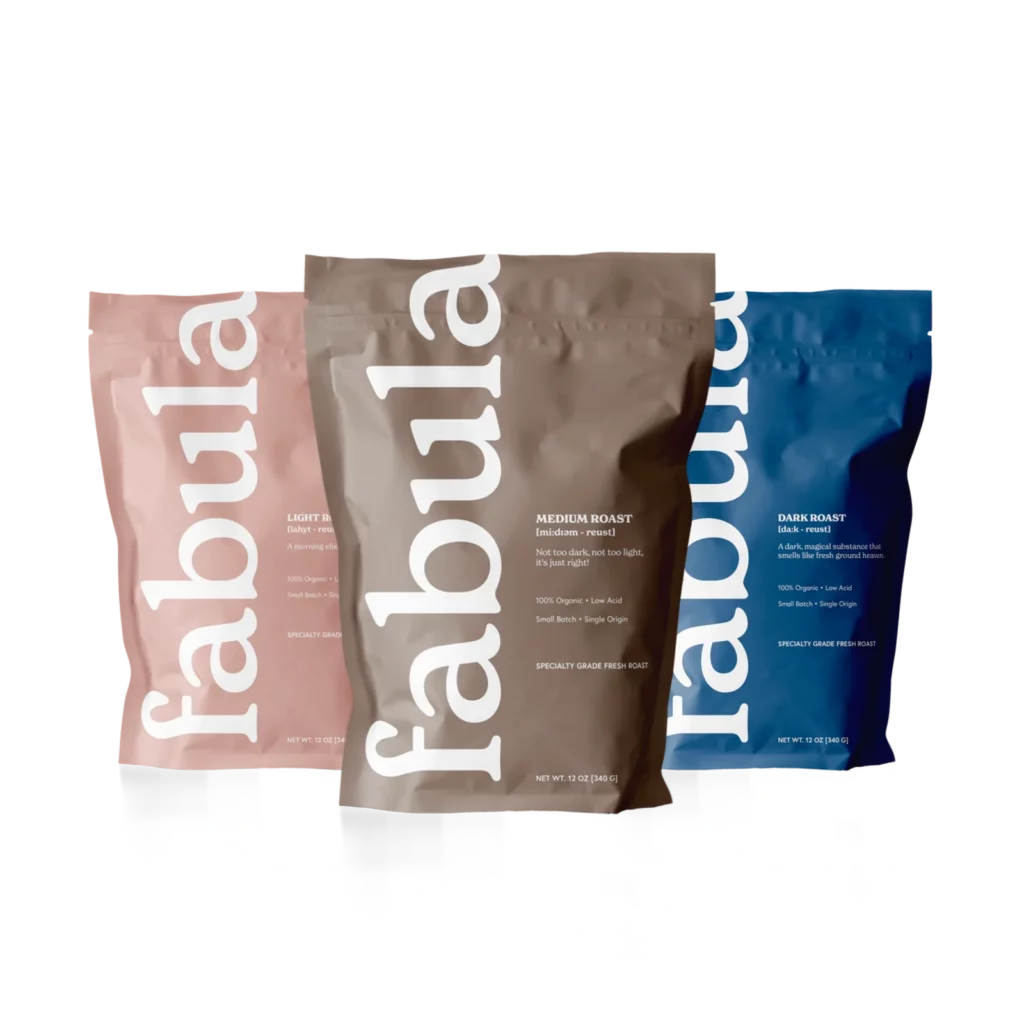
The good news is that it’s not that difficult to find organic coffee these days. Organic coffee is generally a better option not only because it doesn’t require toxic synthetic pesticides when grown and harvested, but it also often means the farmers and others involved in the supply chain are paid fairly.
The most common organic certification you’ll find on coffee (in the U.S. anyway) is USDA Organic. Related labels you may also see on coffee are Fair Trade USA or Fairtrade International (which ensure farmers are paid fairly but doesn’t necessarily have anything to do with pesticide use), Rainforest Alliance Certified (which is more holistic label that requires reduced pesticide use, but does not necessarily mean there aren’t any synthetic pesticides used at all), and Smithsonian Bird Friendly® (which also reduces the amount of pesticides used).
Those who are especially sensitive to mold may also want to choose a coffee brand that is regularly tested and verified to be free from mycotoxins.
Here are some of the best organic coffee brands to check out:
- Fabula (USDA Organic, Fair Trade, mold-free, low-acid)
- Lifeboost (USDA Organic, mold-free, low-acid)
- Purity (USDA Organic, Rainforest Alliance, Bird Friendly, mold-free). You can use the code THEFILTERY20 for 20% off your first order.
- Thrive Market (USDA Organic)
- Four Sigmatic (USDA Organic, also contains adaptogenic mushrooms)
- Stumptown (check the label: many, but not all, are organic)
- Blue Bottle Coffee (check the label: many, but not all, are organic)
One last note here: third-party certifications can be very helpful, especially when buying from larger coffee companies. However, obtaining and maintaining a certification can be costly for small coffee producers, so some farmers opt out of third-party certifications even when they are actually growing organically. Many small, artisan coffee companies have direct relationships with the farmers, so don’t be afraid to ask for more information about the story and process behind the coffees that your local coffee shop sells.
What Should You Store Your Coffee In?
In general, you’ll want to store your coffee in an air-tight container that’s made from glass, stainless steel, ceramic (opt for a white or light-colored one), or even silicone when you’re on-the-go. Klean Kanteen has some good options, as does Planetary Design and Miir.
You can check out more non-toxic food storage options here.
Mold Prevention and Cleaning for Your Coffee Maker
Automatic drip coffee makers and single-serve Keurig-type machines can be especially prone to mold and bacteria growth, which can potentially make you sick. This is in large part because there are a lot more parts and tight spots in these machines compared to alternatives like a Chemex or a French press.
If you’re going to use an automatic coffee maker, remember that prevention is best when it comes to mold and bacteria. It can be very difficult to get rid of mold once it’s growing, especially since even “dead” mycotoxins can cause problems for people with CIRS and mold sensitivity.
The easily removable pieces should ideally be cleaned with dish soap after each use. Take as many of the parts off as you can, leave the lid open, and let everything air dry as much as possible.
Then once every 2-4 weeks, you can clean and de-calcify your machine by putting equal parts water and white vinegar into the machine and running it like you would a pot of coffee. (You don’t necessarily need any fancy coffee maker cleaners or descaling solutions for this.)
If there are any parts you can scrub with a dish or straw cleaning brush, you can do that as well.
This guide will give you more info on how to identify (and prevent) “Keurig sickness” and more tips on how to deal with a moldy coffee maker.





Is there a reason why stainless steel percolators weren’t mentioned? Trying to find my husband an easy nontoxic coffee maker
No, that’s a pretty good option! I did mention them, just not very obviously. It’s under the “Even More Low-Plastic Coffee Brewing Options” section. 🙂
Any recommendations for a safe at home cold brew machine?
Hi Dana, yes – I recommend Ovalware! (https://www.ovalware.com/products/coldbrew) It’s made from glass, stainless steel, and silicone. I did list it in the article, but it’s kind of hidden at the bottom. 🙂
Are Nespresso pods safe? Do you believe them when they say the aluminum pods do not leach? Seems hard to believe given the high heat…
Hi Phil,
I haven’t looked into Nespresso in-depth, but it APPEARS that the pods are lined with something that prevents the aluminum from coming into contact with the coffee. It’s unclear what that lining is actually made out of, but we’ll reach out and ask. We will try and do a deep dive into Nespresso sometime soon!